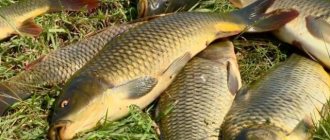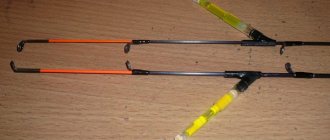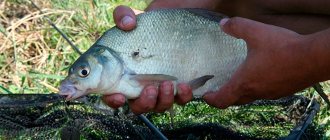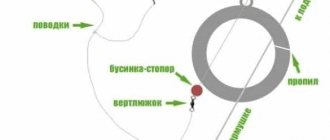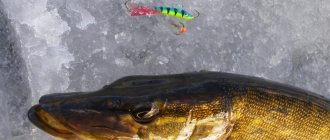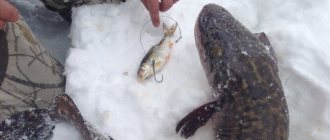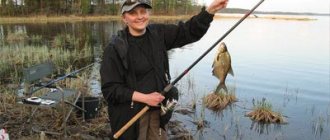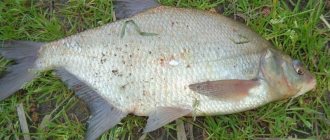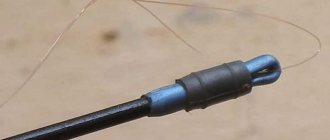Foam plastic for crucian carp fishing
Advantages of catching crucian carp using polystyrene foam
Polystyrene foam has a number of advantages when fishing for crucian carp.
Hooks with foam balls attached to them will stay afloat, which is very convenient when fishing from a silty bottom. In addition, when feeding, crucian carp often raises clouds of silt and is interested in the remains of vegetation that float up from the bottom, looking for insect larvae among them. At the same time, foam balls that move with any movement of water will be attractive to fish
Also, foam plastic does not limp in water, which allows you to avoid throwing gear longer, thereby not scaring off cautious crucian carp by throwing gear
What foam should I use?
Foam balls can have different colors and sizes, you can buy them in a store or prepare them yourself - all this is done at the discretion of the fisherman himself. You should focus on the preferences of crucian carp in a particular body of water.
The store sells foam balls of different sizes, colors, and they are soaked in various aromatic mixtures. You can paint the foam balls yourself, but you should approach this action quite carefully, since the coloring substance may have a strong, unpleasant odor that will scare off crucian carp.
How much foam should I put on the hook?
Ideally, there should be one foam ball on the hook. However, here you should protect yourself from a serious mistake - the hook should float and not lie on the bottom.
In order to make sure of this, you need to test the tackle with mounted foam plastic beads in the water not far from the shore, or test it in advance in some container with water. Hooks must either float or be neutrally buoyant.
If they lie in the mud at the bottom, the chances of a crucian bite are sharply reduced. In this case, you need to either add foam beads to the hooks or use larger beads. The main condition is that they ensure the buoyancy of the hook.
How to place foam on a hook?
It is important how exactly to place the foam when catching crucian carp on a hook. Many fishermen, out of habit, hide the tip of the hook with a foam ball, but this is precisely what should not be done.
The hook tip must be open.
The principle of catching crucian carp with foam balls is that the crucian carp, swimming up to the spring with bait, is interested in the foam plastic with hooks floating next to it and swallows them. Having determined that such bait is inedible, he will try to spit the hook back, which is easily possible if the hook sting is hidden. If it is open, a hook will occur, and the next time the crucian tries to swim away, it will only be better hooked.
Attention! When catching crucian carp using a spring with foam, special attention should be paid to the sharpness of the hooks. Fishing with this method of fishing can only be effective if you have sharp hooks
You need to constantly monitor this and if the hooks become dull, replace them in a timely manner.
Technique for catching bream using polystyrene foam
The whole secret of catching bream using polystyrene foam is that a feeder filled with porridge lies on the bottom, and hooks float a few centimeters above it. The fish, eating the bait, swallows the bait and is hooked.
The foam ball must be highly buoyant in order to lift the hook. They should not lie on the bottom, because in this case the tackle will work ineffectively.
The bream, swimming up to the bait, will purposefully swallow the ball with the hook or do it accidentally. While sucking the porridge, through the spiral of the feeder, the fish creates strong currents of water; a light floating hook can be carried into its mouth. Thus, the tackle has a double action, which explains its effectiveness. Neither the worm nor the corn will fit into the fish’s mouth on their own; you need to wait until it decides to eat them.
To make foam balls more pleasant for bream, they can be placed along with porridge for bait. As a result, within a few hours their smell will be exactly the same.
The fish has a keen sense of smell and will notice this, which will encourage it to swallow the bait. Using large balls, you can weed out bites from small specimens and focus your attention on larger specimens.
Styrofoam balls are sold in different sizes, and it won’t be difficult to find the right one. If you have small ones that are not able to lift the hook you have chosen, then you can put on several of them.
Gear collection
To catch bream using polystyrene foam you will need feeder tackle. It is not necessary to choose the most expensive branded accessories in order to go fishing well. Of course, the quality of the assortment in the upper price segment is usually an order of magnitude higher, but for bream this is not critical.
This fish is strong, fights with the angler when fishing, but is rarely capable of causing damage to gear. To increase the chances of successful fishing with budget accessories, you should take reliable branded consumables. It will be a shame if cheap hooks bend at the slightest load, and the fishing line breaks due to bites from kilogram specimens.
To equip feeder gear for fishing with foam you will need:
- rod;
- coil;
- fishing line or braided cord;
- hooks;
- driving material;
- feeder;
- swivel and carabiner.
Having these components, you can assemble the tackle yourself in less than an hour. Since when bottom fishing, feeders often cling tightly to snags, breakage is a common occurrence. So that in this case you don’t have to go as a lady in the midst of the bite, it will be good to have a replacement set or two.
Rod selection
The length of the rod depends on the body of water. If the bream is far from the shore, then a long cast is required. The longer the rod, the further the feeder will fly. The specificity of working as a feeder involves a backswing. If the bank is overgrown with bushes and trees, then it will be impossible to work with a 5-meter blank without a constant hook.
For most anglers, both beginners and professionals, 3 m of length will be enough.
The weight of the rod is not as important as when fishing for predators with a spinning rod, because there is no need to constantly hold it in your hands. A lightweight form will be more pleasant to use and, if possible, it is better to give preference to it. The rod test is suitable within the range of 80-120 gr. Using a feeder with bait of this weight, in most cases you can count on self-hooking when biting.
Selecting a coil for convenient operation
A spinning reel with a large spool is suitable. If you take a small model, on which only 50-60 m of thick fishing line is wound, you can find yourself in a disadvantageous situation.
In the event of a break, when the angler quickly ties a new feeder to the hanging end of the fishing line, there will be too little supply left. As a result, it turns out that it will not be possible to cast further than 25-30 m. You will have to throw away the remaining piece and start a new line. But when there are a hundred or more meters on the reel, such quick repairs of the gear can be carried out dozens of times.
It is desirable to have the maximum number of bearings, because then fishing will become more comfortable. This requirement is not strict, and it is quite possible to get by with a budget model with two bearings. This does not affect the quality of bites, and with wise fishing, you can pull bream ashore with any reel. The main thing is that it is of high quality and can honestly earn its value.
Selection of feeder for foam plastic and its installation
The optimal feeder would be a spiral type feeder weighing 50-80 grams without bait. Leashes with hooks about 5 cm long are attached to both ends. The specific nature of biting on foam plastic does not allow using a longer length so that it does not move away from the feeder.
Using a carabiner, it is attached to a swivel tied to the main fishing line. This will prevent any twisting. The lead weight should be inside the spring or poured onto one of its sides. The option when it is attached separately for this tackle is not the best solution.
The hook must have a short shank. The ball is punched in such a way that the tip comes out on the other side.
How does polystyrene foam work?
Foam balls are suitable for targeted fishing of most fish belonging to the carp family. For example, for catching crucian carp, bream, large bream, carp, carp, roach or rudd. Why is this fish interested in a completely inedible bait? There is no exact answer to this question, but there are several interesting opinions.
The balls, painted in one color or another, look like grains of corn, peas and other crops. The fish suspects that this is food, but it does not have time to check its assumption. Appetite, greed and competition force her to grab the bait at random. By the way, flavorings help to deceive her almost completely.- The floating ball rises above the feeder to the height of the leash (usually short) and prevents the fish from sucking up the food. She has to constantly push him away with her nose. This happens until the sharp sting sticking out of the foam catches on the lip. Trying to free himself from it, the victim self-cuts himself.
- During the current, light balls play in the water no worse than a jig in the hands of an experienced fisherman. They move enticingly, provoking the fish to bite.
Colored and scented foam balls
Now on sale you can find polystyrene foam in a variety of sizes and colors, with and without a smell, there is even one covered with a special soluble shell (for example, pea). On the issue of coloring, fishermen's opinions were divided. Some believe that there is no need for it, others insist that ordinary white foam plastic is not to the fish’s taste; the ball must definitely resemble something edible. Fortunately, there are no problems with colored baits today.
If earlier you had to paint the foam yourself, using special aerosols and water-repellent felt-tip pens, today you just need to look at the first fishing store you come across and buy a bag of balls of the appropriate color.
Disputes continue over the advisability of aromatizing this bait. Proponents of fishing with odorous material either buy already scented balls, or take regular ones and saturate them with the desired scent themselves. This can be done in two ways: soak in a solution with the addition of garlic, star anise, dill, hemp seeds, vanilla and other natural flavors, or spray with a special spray directly while fishing.
Required Items
Rod
The key requirements for a bottom fishing rod are test and length. Length determines how far you can cast your bait. The longer the rod, the farther your tackle will fly. Test - the minimum and maximum weight of baits that should be used when fishing with this rod.
The set for feeder rods includes additional tips of varying hardness, which are necessary to adjust the sensitivity of the equipment. When choosing such a fishing rod, one must, as a rule, take into account the conditions of the reservoir where fishing is planned.
To cast over long distances, you need to take a longer rod. The best option is a rod with a length of 3500 mm and a test weight of 40 - 80 g. Telescopic fishing rods are of little use for bottom fishing. They do not have the required flexibility; there is no ability to change sensitivity. The maximum distance for them is 40 – 60 m.
Coil
A spinning reel with a rear clutch would be optimal. For a beginner, we can recommend that you first buy an inexpensive Chinese reel, just so that it winds the thread uniformly, does not interfere with its smooth flow when casting, and does not form a beard. However, if funds allow, then you should immediately buy a good one, even if it’s not a branded one.
Fishing line or braided cord
What to choose - fishing line or braid? You need to know their key differences. The fishing line is usually a simple nylon thread. The main parameters of the thread are diameter and resistance to breaking loads. The thicker the thread, the greater the mass of fish it can support. The ideal thread thickness for bottom fishing is 0.25 – 0.40 mm. Braid is more expensive, it is more convenient for use in bottom fishing, has less memory, and does not stretch, which greatly simplifies hooking. With a smaller cross-section, it has greater strength, which significantly reduces the resistance of air and water. The casting distance increases. A cord with a cross-section of 0.20 – 0.28 mm is perfect, this is enough to catch the most powerful and playful bream.
Hooks
For bream fishing, any that meet the following parameters will do. The hook must be sharp and not dull for as long as possible. The size of the hook must match the bait used. The smaller the bait, the smaller the hook. Just know that a fish can bend a hook that is too small or jump off it. Excessively large ones can scare away wary fish. By changing the size of the hook, you can come to the optimal value, when a very small fish will not be able to swallow it, and a large one will not break off.
Manufacturing
When making a bottom fishing rod, the weight plays a key role - it determines the casting distance, keeping the equipment on the bottom and the ease of pulling it out. The heavier the load, the farther the tackle will fly, just do not forget that the weight should not contradict the test of the rod, the performance characteristics of the reel and the cross-section of the thread or braid. There are a lot of gear options. Symbolically, you can divide them into gear with and without a feeder.
To make a bottom rig without a feed container, you need to take a load of suitable weight, tie it to the end of a thread or braid, fix a leader with a hook above the sinker, it is possible to use several leaders. The installation of undergrowth must be done at such a distance that there is no overlap between each other when casting.
Methods are also acceptable when one undergrowth is fixed below the load, and the other above. To eliminate overlaps and twists, you should use rocker arms and anti-twisters, which you can make yourself or buy. A rig with a feeder, which is mounted on a thread, greatly simplifies the fishing procedure. The feed container is made of wire, which is twisted in the form of a spring and filled with lead along the edges.
Fishing technique and tactics
The fishing spot needs to be baited in advance. It is better to use several gears at once to increase the number of prey. Moreover, each one should be thrown at a strictly defined point in order to create the effect of accumulation of feed in one place. When fishing this way, the fish hooks itself, so you need to make sure that after the jerk it doesn’t break the line.
A few secrets of a successful fishing technique:
- It is worth keeping the line taut during fishing until the prey is in the net;
- do not overtighten the line, so as not to tear it with a sharp jerk and lose the trophy;
- constantly rewind the reel;
- pull the fish to the surface with the rod;
- do not let the prey hide in dense thickets, this can lead not only to the loss of the trophy, but also to damage to the gear.
Fishing for crucian carp
Catching crucian carp with a spring is very popular among beginners, because the process itself is simple and does not require the use of special fishing techniques. You need to fill the feeder before casting so that the mixture does not spill out when it hits the water. After lowering the bait to the bottom, the line is tightened. It is better not to move the feeder from its place, as this scares potential prey. Also, when lowering the feeder, part of the food necessarily falls out and lies near the spring, the fish is more willing to collect it, gradually moving towards the bait.
Photo 3. Honey ball with maggots for crucian carp.
Catching crucian carp using foam plastic is incredibly effective, because the fish, carried away by the offered treat, begins to grab the foam plastic, mistaking it for pieces of floating food. The applied polystyrene leaves the sting open and the crucian carp is hooked on its own. During a bite, a sharp jerk is felt, and after that the line sags.
Photo 4. And here is the result!
The principle of hunting bream
It is worth catching bream with several rods, while throwing the first tackle 20-30 m from the shore, and the second 10-15 m further. Place the bait in such a way as to fish the deepest and most promising hole, because it is in such places that bream likes to feed .
Fishing for bream using polystyrene foam using several rods gives positive results almost immediately. For greater attractiveness, it is worth using a mixture with the addition of pearl barley. You can easily catch an individual weighing 1.5-2.5 kg using polystyrene foam.
Foam fishing is a very fun and effective fishing method. The cost of such bait is negligible, but its catchability is enormous. If you paint the foam balls and add flavorings, then not a single fish will be able to resist them. Fishing success is guaranteed with the right location and chosen hunting tactics.
What you should know about bait
The porridge should be washed out well from the feeder and rise up. Therefore, the delicacy must include bran, coconut flakes or rolled oats.
The basis for bait can be made from the following ingredients:
- One part breadcrumbs.
- 0.25 parts corn flour.
- 0.5 parts milk powder.
- 0.3 parts wheat bran.
- 0.25 parts of cake or ground seeds.
If you want, you can paint the balls yellow with food coloring so that they look like corn. This will attract fish.
Foam and foam equipment can be used at any time of the year, although it is best to use it in the summer. During this period, complementary feeding is especially plentiful. The fact is that in spring and autumn, when the water is cold, complementary foods are used in small quantities, so fishing with foam plastic will not give much.
Many fishermen go fishing for bream with the same equipment they use for carp, but this is not true, because the equipment in this case is as follows:
- Bottom or feeder rod.
- Braided cord or monofilament.
- Leashes below the feeder.
- A leash that is located above the feeder.
- Feeder.
It must be said that the tackle for carp is not like any other tackle due to the presence of the crown. When the carp absorbs the cake, stumbles upon a bait made of foam plastic, and swallows the hook, sometimes self-hooking occurs due to the lead plate.
Sometimes they also use a method feeder into which dusty components are placed. The principle of its operation is almost the same as that of the makushatnik.
Foam fishing - choosing gear and bait
Practice shows that polystyrene foam as bait often has an even greater effect than a dung worm or maggot. Especially in heavily silted reservoirs, where living creatures burrow into soft bottom soil, so the fish do not see them. It is difficult to say who and when first began to engage in such fishing as foam fishing. Most likely, this happened not so long ago, because just a few years ago no one knew about such fishing in our country, and if they had heard, they would have twirled their finger at their temple. However, in a surprisingly short time, fishing with foam balls has become very popular.
In its simplest form, this material has neither taste nor smell, and at the same time catches peaceful fish quite well. In addition, it is inexpensive and not in short supply; you can buy it in every fishing store.
Styrofoam balls
Many fishermen have heard this more than once: “I fished with polystyrene foam,” and this is true, although many do not believe it, they fish with polystyrene foam both in its pure form and in tandem with other bait (worm, pearl barley, corn). Previously, fishermen and inventors flavored polystyrene grains with dill and garlic to attract fish, now this has already become an industrial scale; in fishing stores you can buy packaged polystyrene foam of different colors and with different aroma, cocoa, caramel, etc.
Very often this bait is used when fishing on a feeder, but the bait has also proven itself successfully in float fishing and even in winter fishing.
Foam balls
What properties of polystyrene foam allow it to be used as fish bait:
First
– external resemblance to natural food components that are included in the diet of fish, such as bream, roach, silver bream, chub. The foam itself does not have any odor that could attract fish, but its appearance resembles the shape of peas, pearl barley, corn, wheat, or dough balls. It’s not for nothing that foam plastic is tinted in production to match the color of different grains of cereal crops.
It is assumed that a fish standing in a fast current not only gets used to picking up food from the bottom, but must also have time to grab it when it swims by. In such a situation, the fish only visually evaluates the floating object, because, if anyone doesn’t know, the fish’s vision is mediocre; the fish, seeing a flashing foam ball in the river streams, instinctively grabs it so that potential food does not reach its relatives.
Those who didn’t make it in time are lost, it’s a joke. This is the whole point of polystyrene foam: for river fishing it can be used in its original form, without tint or smell.
Second
– this is buoyancy, a ball put on a hook, regardless of the current, “flies” in the water column, attracting fish. Therefore, it can be used to lift the bait from the bottom when the fish does not want to take it from the bottom.
Also interesting: Bite activator
Third
– polystyrene foam can retain odor.
Quadruple
– this is similar to natural bait.
Fifth
– The foam ball holds firmly on the hook, even if the puncture does not stick through the hook and does not fly off. Therefore, if after catching the fish the ball is not deformed, it can not be changed. And the most important thing for every fisherman is that the bait is actually free and it does not require time to prepare. Polystyrene foam is durable, does not take up much space and is lightweight, so thrown into a backpack or bag it will remain there until it is completely used up.
Tested in practice
Very small and large foam balls are not suitable; a suitable diameter is 4-6 mm. When using rigid foam, there are more empty undercuts. One granule is strictly placed on the hook. Experiments carried out with two or three granules did not produce a noticeable difference.
Very important:
the point of the hook should go out, we don’t fish with natural bait, which almost always has to fly off when hooking in order to hook the fish well. The foam ball most often remains intact on the hook when catching fish, so you can immediately throw the equipment. As I mentioned above about small balls, sometimes they help with unstable fish biting and when you have to look for approaches to it, so you still need to throw a few of them in your bag, as they say, just in case. This also includes small hooks.
Feeding the fish before fishing is a prerequisite for successful fishing. The fish gathers at the smell of the bait and grabs the foam, perceiving it as part of the nutritious ingredient of the food. Therefore, if we use polystyrene with a smell, the same aroma should be present in the bait; let’s use foam with the aroma of cocoa, then the bait should contain such an aroma.
Also interesting: Privada
When we form a “sandwich” on a hook in which foam plastic is present, you need to pay attention to its weight, the foam plastic should keep the bait afloat, and not the force of the river current. Then the bait will play better in the thickness of the water jets
Therefore, we put a foam ball on the hook, then lower the worm and corn bait into the water and watch how our “buoy” keeps the bait on the pilaf; if everything is so bad, then we increase the size of the foam or reduce the size of the natural bait.
In conclusion, I want to say that the use of a foam ball is not limited only to river fishing, where the current is a good helper for the fisherman. Experimental fishermen talk about excellent results from using this bait in ponds when fishing for crucian carp and crucian carp. Try it, experiment, good luck on the pond.
Read further:
Fishing for crucian carp in winter
Fishing for crucian carp in winter
Fishing for crucian carp in May
Why fish are caught on foam plastic
For one of two reasons:
- The fish mistakes the foam for food and grabs it, knowing that the food that floats past must be swallowed.
- The fish perceives the foam as garbage, as an obstacle that prevents it from getting to the food, and tries to get rid of it by tearing it out with its mouth or pushing it away with its forehead.
In the first case, all fishing tactics are based on the vision and greed (appetite) of the fish.
The foam is made in the form of grain and tinted to match the color of the plant attachment - to match corn, peas, dough, and so on. Flavorings are often used to add a smell to the bait. In the second case, the fishing strategy is based on the anger and greed (appetite) of the fish. Seeing that the foam prevents her from eating the food, she will pull it out more and more each time or push it away, and eventually get caught with her lip or forehead. It is convenient that the nozzle does not need to be tinted or scented.
Fishing with a donk from the shore, fishing with a bottom rod (tackle)
Home » Home » Fishing with a bottom rod from the shore, fishing with a bottom rod (tackle), video
Fishing with a bottom rod (tackle)
Donka fishing from the shore
Fishing with a donk from the shore has many advantages over other fishing methods.
- firstly, they usually catch large fish with a donk
- secondly, fishing is carried out at a distance from the shore, a large part of the reservoir is fished
- thirdly, almost any fish was caught
- fourthly, low requirements and cost of gear
The most common donkey is a tackle consisting of a regular reel, a fishing line wound on it, with leads and a sinker.
The tackle is compact, lightweight and portable. But you have to throw such gear manually, which is not entirely convenient.
A more advanced option for fishing with a bottom fishing rod is to equip it with a rod and reel (for example, a spinning rod).
This option makes casting gear and landing fish much easier.
There is also a difference in the choice of bait, depending on the body of water and the type of fish that we are going to catch.
What does bottom fishing from the shore look like?
Let's look at the gear in more detail.
- Rod. Almost any, except the lightest, for casting with dough from 50 grams and above, with a length of one and a half meters.
- The reel can also be of any kind, but preferably an inertia-free one, since it increases the casting range and has a friction adjustment, which prevents the line from breaking when landing trophy fish.
- Fishing line. It is better to use fishing line rather than cord. It clings less to bottom obstacles and is less prone to abrasion on underwater rocks. The diameter of the main line is usually used from 0.4 millimeters to 0.6. Leashes from 0.25 to 0.4 millimeters.
- Sinker. You can use both purchased and homemade ones, cast from lead in various forms. The stronger the current, the heavier the sinker.
- Various baits are used as bait: worm, crawler, lamprey larva (loach), live bait.
- Hooks are used depending on the type of bait and the intended catch of fish, but long shanks are preferable.
The sinker at the bottom is tied at the end of the main fishing line through a carabiner with a swivel (to prevent twisting) through a piece of fishing line that is slightly thinner than the main line, so as not to lose the entire tackle when hooked.
Leashes (usually 2 to 3) are tied in front of the sinker (this arrangement allows you to feel the bite more subtly). The length of the leashes is 20-40 centimeters. The distance between the leashes should be greater than twice the length of the leashes (so that they do not overlap).
Fishing takes place from the shore; you can fish with several donks at the same time.
Hooks are tied in a variety of ways, for example, loop-to-loop or “new” using triple swivels and carabiners.
Instead of one of the leashes, sometimes a feeder is tied to attract fish. Or the feeder is made heavy and used at the same time as a sinker.
Bottom fishing
A bite alarm is served by the tip of the rod, a special bell suspended on a clothespin, for example, or simply a stick with a cleft hanging on the fishing line. There are also electronic bite alarms. Both sound and light. The main thing is that all these devices do not interfere with fishing.
In general, bottom fishing often brings good luck. When other gear is simply powerless.
In conclusion, the video of fishing with a donk from the shore:
Latest searches:
- carp on donka on the lake from the shore
- how to fish with donka video
- fishing with bottom tackle spring 2017
- What does a donka look like?
- how to fish for donka
- signaling tip for spinning rod for bottom fishing
- Donka fishing
Tackle for polystyrene foam and installation of equipment
To fish with polystyrene foam, you will need a donk with a feeder, somewhat different from a classic feeder. Since such a nozzle involves self-hatching of fish, it is advisable that the equipment for fishing with foam plastic be deaf. In general, the tackle consists of:
a feeder or spinning rod with dough selected for the weight of the feeder (preferred length is 2.4-3.6 meters);- inertia-free reel with a capacious spool and friction brake;
- fishing line with a cross section of up to 0.4 mm;
- open spring-type feeder;
- short leashes no more than 4 cm long;
- hooks corresponding to the size of the object being fished.
Something more about catching crucian carp using polystyrene foam
In addition to the method of catching crucian carp using polystyrene foam, which is described above, polystyrene foam can help out the fisherman in many other cases. This mainly applies to reservoirs with heavily silted bottoms. Fishing on such reservoirs sometimes ends in complete fiasco, especially if you fish on a feeder with a feeder. And even with a float, when fishing from the bottom, you often won’t get a bite.
The thing is that the bait is simply not visible to the fish. It either sinks into the silt along with the feeder when fishing with a feeder, or is practically invisible to crucian carp when fishing with a float rod. But if you can still correct the situation with a float rod by periodically twitching the rod so that the bait moves, then on a feeder you won’t be able to play with the bait that much. I am sure that experienced fishermen have noticed more than once that after moving the bait, a bite occurred - this is precisely what indicates the problem of the invisibility of your bait.
In such cases, foam comes to the rescue. It is enough to place the foam on one hook with the main nozzle and your bait will immediately become much more noticeable to fish and for silted reservoirs this is practically the only salvation from lack of bite
Firstly, the foam will prevent the bait from drowning in the silt, and secondly, the foam itself is white and contrasts very well against the background of the silt, attracting the attention of crucian carp
If the pond is silted, first place a foam ball on the hook, and then corn, peas, maggots, a worm or any other bait. This kind of sandwich with polystyrene foam will save your fishing more than once when fishing on a reservoir with a heavily silted bottom. Just be careful, not only crucian carp are caught using polystyrene foam. This attachment works well when catching grass carp and silver carp; often roach, rudd and even carp are caught on the foam. As you can see, a fairly powerful specimen may be caught among the catch; cupid, silver carp or carp can easily break the tackle or drag it into the water, so you should be prepared for such surprises.
Tips for successfully catching bream using polystyrene foam
Catching bream using bottom tackle is very common. A lot of animal and plant baits are used, which the fish take with varying degrees of success.
A universal solution in this regard is to catch bream using polystyrene foam, because catchability does not depend on water temperature or season. It is also important that this bait does not deteriorate and can be stored in fishermen’s supplies for years. It is consumed slowly and is very cheap. All expenses depend only on the purchase of tackle and bait.
The principle of operation of foam plastic as a nozzle
Fishing with foam balls is quite effective. Polystyrene foam is a good bait. It is easy to use, it does not fall off the hook, and does not get lost when casting. It is similar to the natural food that fish eat. The foam balls are shaped like pea or corn kernels. Stores sell colored foam plastic balls for fishing that imitate cereals.
In a fast current, the fish quickly captures prey, takes food at the bottom, and swallows food floating nearby. River dwellers are not distinguished by their keen eyesight; they can see objects at a distance of 1 m. Therefore, when they see a ball, they grab it as soon as possible so that other individuals do not get it.
The polystyrene foam is lightweight, so it does not sink and will remain in the water, attracting the attention of fish. The price of the material is quite small; such bait costs the fisherman almost nothing
The material holds odors well. You can soak the bait with an aromatic substance, the smell of which will last for a long time.
This material is well combined with animal bait; together with it, you can attach a larva or maggot to the hook. The balls are held perfectly on the hook. The piece of material is small in size and easily fits even in a pocket. This bait is quickly put on the hook, saving time in preparation for fishing. The material has a long service life and does not lose its shape.
Experienced fishermen use a feeder for such fishing. Without it, it is difficult to catch prey on foam pieces, even if they have an attractive smell and bright color.
When the fish swims up to the feeder, the ball rises and prevents it from swallowing the food. She pushes him away until she gets caught on the hook. The fish tries to free itself from the hook, thereby getting even more attached to it. During the current, the bait plays, causing individuals to bite.
Otherwise, the equipment for fishing with foam is standard and includes the following components:
- fishing rod from 2 to 3.7 m;
- fishing line with a diameter of 0.3 mm;
- spinning reel;
- sinker weighing up to 100 g;
- hooks for fixing on leashes - 4-5 pcs.;
- a spring 1.5 thick and no more than 10 cm long.
The installation of the feeder differs from the standard one: it is fixed firmly to the main fishing line, without using any loops. The best form of feeder is an open spring, with the weight located at the bottom. This shape will allow the food to be on top. The weight of the feeder with bait should not be more than 140 g.
Foam fishing will be more effective if you use several leads. Installation is done like this:
- You need to fix it on the sides of the feeder.
- For leashes, use a thin thread, preferably a braided line 0.1 mm thick. Leash length - 5-6 cm.
- Hooks number 4, sharp and durable.
- The pieces are placed so that the end of the hook remains open.
The balls are made of such a size that they hold the hooks vertically above the feeder. Foam baits can be used both summer and winter; in winter they need to be treated with a special spray, the smell of which will attract fish.
Features of catching bream using polystyrene foam
Sports gear loses its relevance when fishing with foam. Leave the sporting tackle to the sports fishermen. Set yourself the task of catching bream. Just not for the sake of taking a photo with him and not for the sake of selling the catch, but in order to get an unforgettable experience and pleasure.
There are many advantages to recreational fishing for bream. The first and huge advantage is the universal gear; you are unlikely to find anything similar among sport fishermen.
And it is important that when using cheap feeder gear, the result will be no worse than when fishing with expensive and “popular” gear. Why overpay?
Often, fishermen with two Chinese springs, bought on the market for pennies, catch much more than people with expensive feeders from popular manufacturers.
If you are a fan of the classic feeder, then you will need to use one rod, since you are unlikely to succeed based on the behavior of the tips of two or more. Choosing the optimal weight of the feeder for fishing will not be an easy task. The further you plan to cast, the harder it is to choose a feeder. The leash size will need to be adjusted.
Foam without fragrances is very often used. And if you decide to add a scent to it yourself, then you need to pay attention to ensure that it does not scare away the bream. It is recommended to immerse the balls in bait for 5-10 hours so that they are saturated with its smell. Such foam will attract bream from all over the reservoir. The diameter of the balls must be selected based on the size of the hooks. And give preference to foam plastic, which will not be pressed to the bottom under the weight of the hook. And small balls will attract small fish, and not a single angler has ever lost the desire to catch a big fish.
